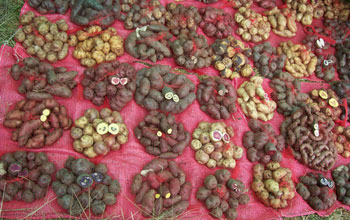News Release 11-137
New Genetic Map of Potato May Lead to Improved Crops
Improved potato crops would help feed the hungry

Various types of potatoes that are grown in Peru.
July 11, 2011
View a video with Robin Buell of Michigan State University.
This material is available primarily for archival purposes. Telephone numbers or other contact information may be out of date; please see current contact information at media contacts.
An international consortium of scientists has produced a new map of the potato genome that may lead to the development of an ultra-nutritious potato that could help feed the world's hungry.
By sequencing and identifying genes in the genome of the potato, the consortium has, for the first time, tied specific potato genes to their functions. Resulting insights into the growth and development of potatoes may enable scientists and breeders to produce potatoes that are more nutritious, more disease resistant and less dependent on pesticides than conventional potatoes.
The potato is the world's number one non-grain food commodity, and serves as a primary source of energy for many poor people in developing countries. What's more, the popularity of the potato is expected to increase as the world's population soars. Therefore, by improving the nutritional value of potato crops and making potatoes easier to grow, scientists will increase the nutritional intake of a large and expanding population of potato-dependent people.
The National Science Foundation funded the consortium's research, which was published online July 10 by the science journal Nature.
Potato crops are particularly popular in developing countries because they yield food quicker and require less land than any other major crop--major advantages in developing countries where pressure on land and water is fierce. In addition, potatoes can be grown in varied landscapes, including mountains, plains, plateaus and subtropical lowlands.
The consortium released a draft map of the potato genome in 2009. However, Robin Buell, a Michigan State University plant biologist who is a member of the consortium, explained, "since our initial release of the sequence in 2009, we have improved the quality, identified and analyzed the genes and analyzed the genetic basis for the biology of the potato and its tuber," which is the edible part of the potato.
For more information about the new genetic map of the potato, see Michigan State University's press release on honing the potato genome.
-NSF-
-
View Video
Robin Buell of Michigan State University explains the importance of the potato genome.
Credit and Larger Version
Media Contacts
Lily Whiteman, National Science Foundation, (703) 292-8310, email: lwhitema@nsf.gov
Layne Cameron, Michigan State University, (517) 353-8819, email: layne.cameron@ur.msu.edu
Program Contacts
Diane Okamuro, National Science Foundation, (703) 292-4400, email: dokamuro@nsf.gov
Co-Investigators
Robin Buell, Michigan State University, (517) 353-5597, email: Buell@msu.edu
Related Websites
Study reveals methods used by microbes that caused Irish Potato Blight: http://www.nsf.gov/news/news_summ.jsp?cntn_id=117036
Research on the family of plants that includes potatoes: http://solanaceae.plantbiology.msu.edu
The U.S. National Science Foundation propels the nation forward by advancing fundamental research in all fields of science and engineering. NSF supports research and people by providing facilities, instruments and funding to support their ingenuity and sustain the U.S. as a global leader in research and innovation. With a fiscal year 2023 budget of $9.5 billion, NSF funds reach all 50 states through grants to nearly 2,000 colleges, universities and institutions. Each year, NSF receives more than 40,000 competitive proposals and makes about 11,000 new awards. Those awards include support for cooperative research with industry, Arctic and Antarctic research and operations, and U.S. participation in international scientific efforts.
Connect with us online
NSF website: nsf.gov
NSF News: nsf.gov/news
For News Media: nsf.gov/news/newsroom
Statistics: nsf.gov/statistics/
Awards database: nsf.gov/awardsearch/
Follow us on social
Twitter: twitter.com/NSF
Facebook: facebook.com/US.NSF
Instagram: instagram.com/nsfgov



